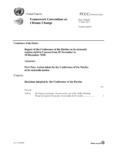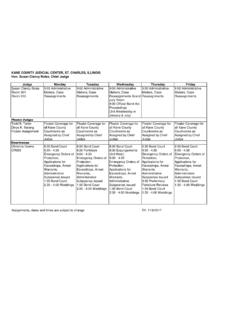Transcription of MANAGING LYME DISEASE - lymenet.org
1 This watermark does not appear in the registered version - ADVANCED TOPICS IN. LYME DISEASE . DIAGNOSTIC HINTS AND TREATMENT. GUIDELINES FOR LYME AND OTHER. TICK BORNE ILLNESSES. sixteenth Edition Copyright October, 2008. JOSEPH J. BURRASCANO JR., Board Member, International Lyme and Associated Diseases Society DISCLAIMER: The information contained in this monograph is meant for informational purposes only. The management of tick-borne illnesses in any given patient must be approached on an individual basis using the practitioner's best judgment. This watermark does not appear in the registered version - TABLE OF CONTENTS. BACKGROUND INFORMATION. What is Lyme DISEASE .. 3. General 3. Hypothalamic-Pituitary 4. Co-Infection ..4. Collateral Conditions .. 5. LYME BORRELIOSIS. Diagnostic Hints .. 6. Erythema 7.
2 Diagnosing Later DISEASE .. 7. The CD-57 SYMPTOM DIAGNOSTIC 11. LYME DISEASE TREATMENT GUIDELINES. LYME BORRELIOSIS. General Information .. 12. Treatment Resistance .. 12. Combination 12. Borrelia 13. TREATING LYME BORRELIOSIS. Treatment 13. 13. Course During Therapy .. 16. ANTIBIOTIC CHOICES AND DOSES. Oral 17. Parenteral 18. TREATMENT CATEGORIES. Prophylaxis .. 19. Early 19. Disseminated .. 19. Chronic Lyme DISEASE (persistent/recurrent infection) .. 20. Indicators for Parenteral Therapy .. 20. ADVANCED TREATMENT OPTIONS. Pulse Therapy .. 20. Combination 21. LYME DISEASE AND 21. MONITORING THERAPY AND SAFETY .. 21. CO-INFECTIONS IN LYME. Piroplasmosis (Babesiosis).. 22. Bartonella-Like 23. Ehrlichia/Anaplasma .. 24. Sorting Out 24. SUPPORTIVE THERAPY.. 26. Nutritional 27. 30. Rehab/Physical Therapy 31.
3 MANAGING Yeast 32. BITE PREVENTION AND TICK 34. SUGGESTED READING AND RESOURCES .. 35. MANAGING LYME DISEASE , 16h edition, October, 2008. Page 2 of 37. This watermark does not appear in the registered version - WELCOME! Welcome to the sixteenth edition of the Guidelines . Amazingly, this edition is not only the sixteenth in the series, but as the first edition appeared in 1984, this reflects twenty four years of effort! Since the last edition, enough new information has become available to justify this revision. New insights regarding co-infections, tests and treatment regimens are included. Nearly every item has been revised, but despite great effort to condense the information, the huge amount of new information included here has resulted in more pages than ever. Information included here is based on the literature, presentations at scientific meetings, the many valuable observations noted by my colleagues, plus experience from caring for my own patients.
4 I have tried to make this information as up-to-date as possible and as inclusive as is practical. Please use the information presented in this document as an information resource and guide. It can never replace your own experience and clinical judgment. I once again extend my best wishes to the many Lyme patients and their caregivers whose wisdom I deeply appreciate, and a sincere thank you to my colleagues whose endless contributions have helped me shape my approach to tick borne illnesses. I hope that this new edition proves to be useful. Happy reading! BACKGROUND INFORMATION. WHAT IS LYME DISEASE ? I take a broad view of what Lyme DISEASE actually is. Traditionally, Lyme is defined an infectious illness caused by the spirochete, Borrelia burgdorferi (Bb). While this is certainly technically correct, clinically the illness often is much more than that, especially in the disseminated and chronic forms.
5 Instead, I think of Lyme as the illness that results from the bite of an infected tick. This includes infection not only with B. burgdorferi, but the many co-infections that may also result. Furthermore, in the chronic form of Lyme, other factors can take on an ever more significant role- immune dysfunction, opportunistic infections, co- infections, biological toxins, metabolic and hormonal imbalances, deconditioning, etc. I will refer to infection with B. burgdorferi as Lyme Borreliosis (LB), and use the designation Lyme and Lyme DISEASE to refer to the more broad definition I described above. GENERAL PRINCIPLES. In general, you can think of LB as having three categories: acute, early disseminated, and chronic. The sooner treatment is begun after the start of the infection, the higher the success rate.
6 However, since it is easiest to cure early DISEASE , this category of LB must be taken VERY seriously. Undertreated infections will inevitably resurface, usually as chronic Lyme, with its tremendous problems of morbidity and difficulty with diagnosis and treatment and high cost in every sense of the word. So, while the bulk of this document focuses of the more problematic chronic patient, strong emphasis is also placed on earlier stages of this illness where closest attention and care must be made. A very important issue is the definition of Chronic Lyme DISEASE . Based on my clinical data and the latest published information, I offer the following definition. To be said to have chronic LB, these three criteria must be present: 1. Illness present for at least one year (this is approximately when immune breakdown attains clinically significant levels).
7 2. Have persistent major neurologic involvement (such as encephalitis/encephalopathy, meningitis, etc.). or active arthritic manifestations (active synovitis). 3. Still have active infection with B. burgdorferi (Bb), regardless of prior antibiotic therapy (if any). Chronic Lyme is an altogether different illness than earlier stages, mainly because of the inhibitory effect on the immune system (Bb has been demonstrated in vitro to both inhibit and kill B- and T-cells, and will decrease the MANAGING LYME DISEASE , 16h edition, October, 2008. Page 3 of 37. This watermark does not appear in the registered version - count of the CD-57 subset of the natural killer cells). As a result, not only is the infection with Bb perpetuated and allowed to advance, but the entire issue of co-infections arises. Ticks may contain and transmit to the host a multitude of potential pathogens.
8 The clinical presentation of Lyme therefore reflects which pathogens are present and in what proportion. Apparently, in early infections, before extensive damage to the immune system has occurred, if the germ load of the co-infectors is low, and the Lyme is treated, many of the other tick- transmitted microbes can be contained and eliminated by the immune system. However, in the chronic patient, because of the inhibited defenses, the individual components of the co-infection are now active enough so that they too add to features of the illness and must be treated. In addition, many latent infections which may have pre-dated the tick bite, for example herpes viruses, can reactivate, thus adding to the illness. An unfortunate corollary is that serologic tests can become less sensitive as the infections progress, obviously because of the decreased immune response upon which these tests are based.
9 In addition, immune complexes form, trapping Bb antibodies. These complexed antibodies are not detected by serologic testing. Not surprisingly the seronegative patient will convert to seropositive 36% of the time after antibiotic treatment has begun and a recovery is underway. Similarly, the antibody titer may rise, and the number of bands on the western blot may increase as treatment progresses and the patient recovers. Only years after a successfully treated infection will the serologic response begin to diminish. The severity of the clinical illness is directly proportional to the spirochete load, the duration of infection, and the presence of co-infections. These factors also are proportional to the intensity and duration of treatment needed for recovery. More severe illness also results from other causes of weakened defenses, such as from severe stress, immunosuppressant medications, and severe intercurrent illnesses.
10 This is why steroids and other immunosuppressive medications are absolutely contraindicated in Lyme. This also includes intra- articular steroids. Many collateral conditions result in those who have been chronically ill so it is not surprising that damage to virtually all bodily systems can result. Therefore to fully recover not only do all of the active infections have to be treated, but all of these other issues must be addressed in a thorough and systematic manner. No single treatment or medication will result in full recovery of the more ill patient. Only by addressing all of these issues and engineering treatments and solutions for all of them will we be able to restore full health to our patients. Likewise, a patient will not recover unless they are completely compliant with every single aspect of the treatment plan.





